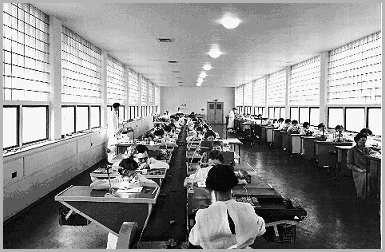
The Visitor 5
Careful inspection at all stages
At every stage of production at Gurnos Works it is apparent that great care is given to inspection. Special inspection benches are located at strategic points in the factory, and every batch of parts is checked and examined by a specially trained staff armed with accurate gauges and very high magnification optical
instruments. This sort of check-up takes place many times as the various component parts of the watch movements pass on, stage by stage, towards the point where they are finally passed as correct for assembly. Defective parts are detected astonishingly quickly, for inspection has the dual purpose of preventing incorrectly made components from passing to assembly, and of locating the error in manufacture which caused them.
Every process has something of interest for the visitor, but it is only possible to select a few for brief description. Jewel setting is one, for it is a triumph of good tooling. The setting for the pressed-in jewel is cut to the exact size, and the jewel placed in position by a girl and pressed home by a small, accurately controlled press so swiftly that a number of jewels have been inserted into their plates or bridges before the onlooker has followed the details of the operation.
The finished part stores is attractive to anyone with a tidy and methodical turn of mind. Large quantities of parts are stored in glass jars which make some sections look rather like a sweet shop. Each calibre of watch has its own colour-code, which appears on each jar or storage bin (some parts, obviously, do not lend themselves to storage in jars) and, indeed, on all labels, tools, drawings, etc. relating to that particular calibre.
13 ligne gents wristwatch assembly

In any watch factory, however, the supremely interesting point is the assembly department where all the planning and precise work devoted to the various component parts becomes centred in the working, time-measuring movements. At the Gurnos Works, this division of the factory really is a division, housed in a separate semi air-conditioned and dust-proofed two-storey building behind the machine shops. There is even a small ceremony before one enters, for everyone must (this is an order) put on overshoes that are designed to prevent any dirt that may linger on even carefully-wiped shoes from reaching the spotless floors.